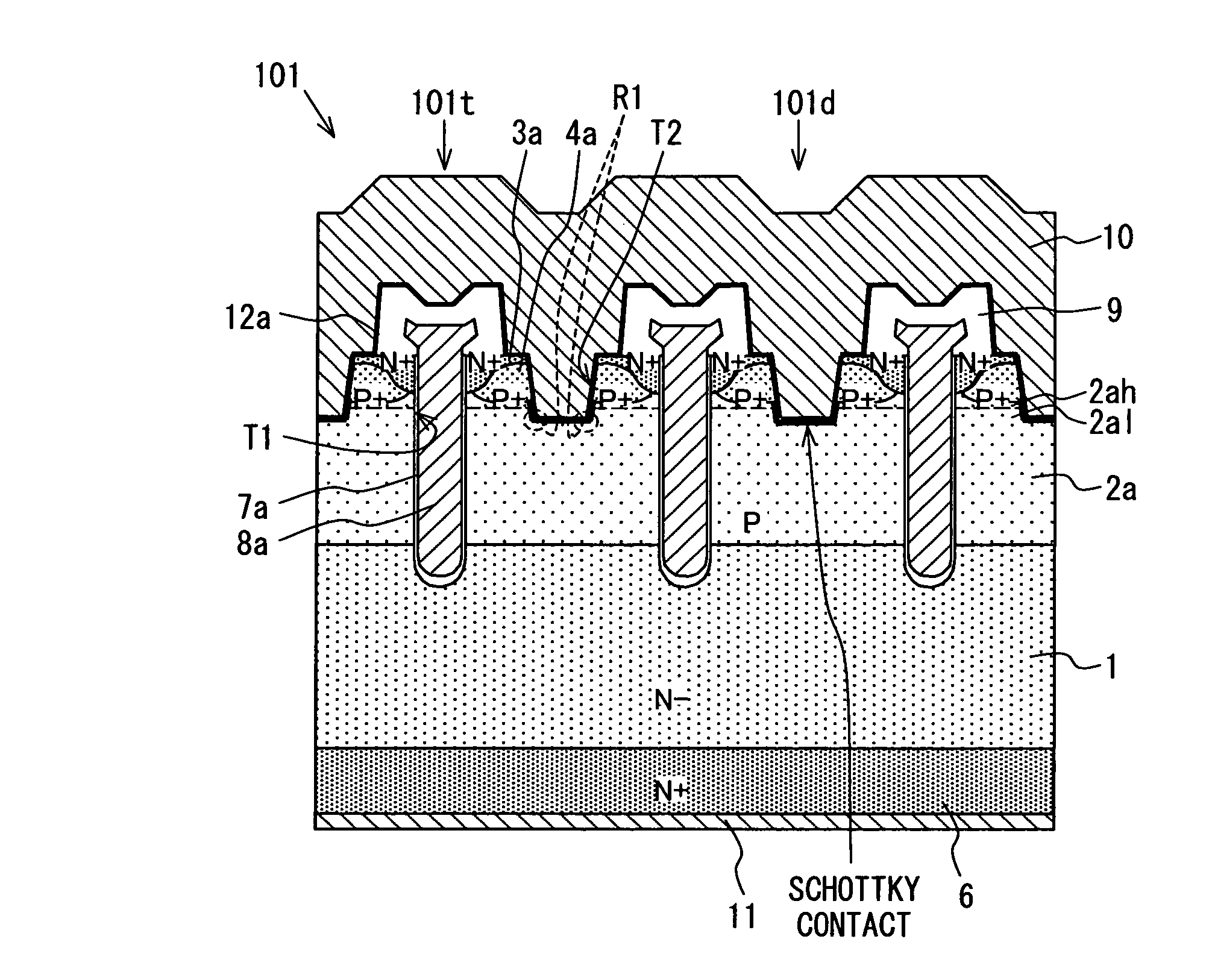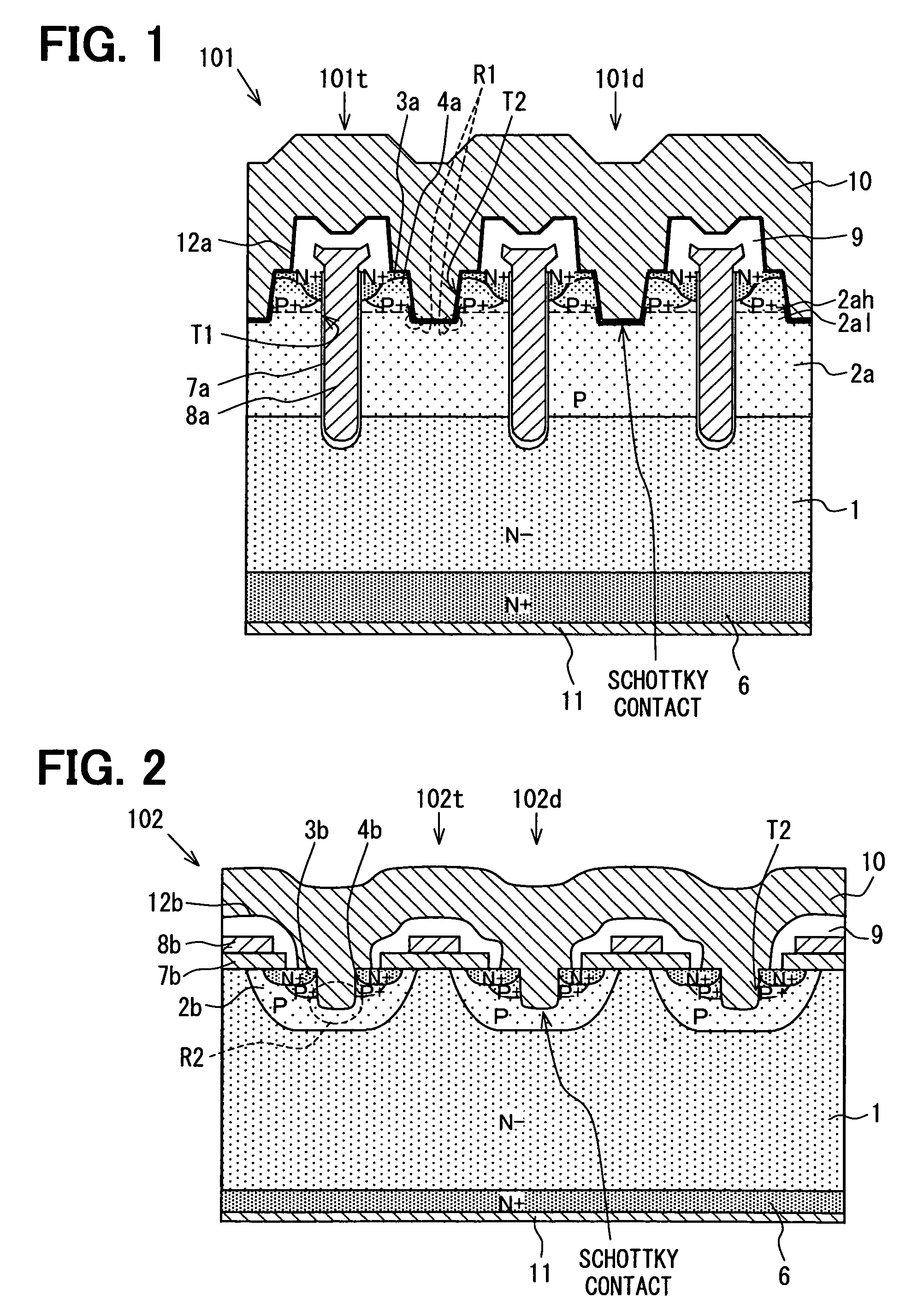Semiconductor device and manufacturing method thereof
a semiconductor and semiconductor technology, applied in semiconductor devices, diodes, electrical devices, etc., can solve the problems of inability to apply the above-mentioned method, the inability to recover properties, and the inability to achieve the effect of recovery property
- Summary
- Abstract
- Description
- Claims
- Application Information
AI Technical Summary
Benefits of technology
Problems solved by technology
Method used
Image
Examples
first embodiment
[0079]Hereinafter, a first embodiment of a semiconductor device will be described with reference to FIG. 1. FIG. 1 is a cross sectional side view (a view of a cross sectional structure seen from a side surface) of a semiconductor device 101 according to the first embodiment. As shown in FIG. 1, the semiconductor device 101 of the present embodiment has a structure based on the semiconductor device 90 shown in FIG. 15, and with respect to the same component with one included in the semiconductor device 90, the same reference numerals are applied.
[0080]As shown in FIG. 1, the semiconductor device 101 includes a semiconductor substrate 1 including both a trench type MOS transistor cell (hereinafter also referred to as “MOS transistor cell”) 101t and a diode cell 101d. In other words, a plurality of trench type MOS transistor cells 101t, each of which includes a parasitic diode cell 101d, are formed in the semiconductor substrate 1.
[0081]Specifically, in the semiconductor device 101, a ...
second embodiment
[0097]Hereinafter, a second embodiment of a semiconductor device will be described with reference to FIG. 2. FIG. 2 is a cross sectional side view of a semiconductor device according to the present embodiment.
[0098]As shown in FIG. 2, a semiconductor device 102 of the second embodiment has a structure based on the semiconductor device 101 shown in FIG. 1. That is, in the semiconductor device 102, a plurality of MOS transistor cells 102t and diode cells 102d, which are similar to the structures of the MOS transistor cell 101t and the diode cell 101d in the semiconductor device 101, are formed over the n-conductive type semiconductor substrate 1. However, the MOS transistor cell 102t is not a trench type MOS transistor in the semiconductor device 102 and a plurality of planar type MOS transistors are formed in the semiconductor substrate 1.
[0099]In other words, in the semiconductor device 102 as well as the semiconductor device 101, a p-conductive type (P) region 2b, in which an impur...
third embodiment
[0104]Hereinafter, a third embodiment of a semiconductor device will be described with reference to FIG. 3. FIG. 3 is a cross sectional side view of a semiconductor device according to the embodiment.
[0105]As shown in FIG. 3, a semiconductor device 103 of the present embodiment has a structure based on the semiconductor device 101 shown in FIG. 1. That is, in the semiconductor device 103, a plurality of MOS transistor cells 103t and diode cells 103d, which are similar to the structures of the MOS transistor cell 101t and the diode cell 101d in the semiconductor device 101, are formed over the n-conductive type semiconductor substrate 1.
[0106]However, as shown in FIG. 3, in the semiconductor device 103 of the present embodiment, a main side second p-conductive type (P) region 2c is arranged in the main side surface portion of the n-conductive type semiconductor substrate 1 of a region, which is a different position from the diode cell 103d, and at which the p-conductive type layer 2a...
PUM
 Login to View More
Login to View More Abstract
Description
Claims
Application Information
 Login to View More
Login to View More - R&D
- Intellectual Property
- Life Sciences
- Materials
- Tech Scout
- Unparalleled Data Quality
- Higher Quality Content
- 60% Fewer Hallucinations
Browse by: Latest US Patents, China's latest patents, Technical Efficacy Thesaurus, Application Domain, Technology Topic, Popular Technical Reports.
© 2025 PatSnap. All rights reserved.Legal|Privacy policy|Modern Slavery Act Transparency Statement|Sitemap|About US| Contact US: help@patsnap.com



